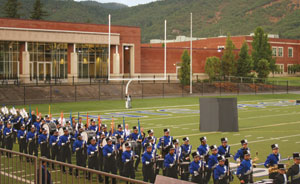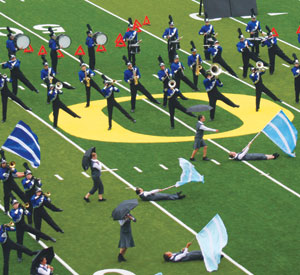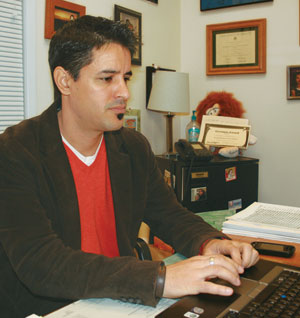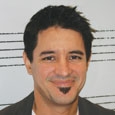Last November the Grants Pass High School Marching Band made the 3,000-mile trek from Oregon to New York to perform in the 2010 Macy’s Thanksgiving Day Parade, a trip two years in the making. We chatted with director Jason Garcia to get the details on undertaking the trip and came away with the story of not just a fascinating trip, but a fascinating music program.

How did you train students to march the long route for Macy’s?
We haven’t marched any big parades, so it took extra conditioning for the 2.8-mile route. Two weeks before the parade I found a route about an hour away, at the White City Domiciliary, the veterans hospital. The route went around the perimeter of the entire facility, on a road that varied between two and three lanes. Many people came out of the building and had no idea what was going on, but they applauded us as we passed.
We marched the loop until we had gone about four miles playing our first parade tune, a Christmas medley, then a 40-second cadence, then our other parade tune, an upbeat,“Mercy, Mercy, Mercy.” Macy’s wanted something upbeat and lively and did not want all Christmas music.
What was the difference between planning a parade show and a football field show?
At the parade showcase, there was no room for a drum major or director and no yard lines or reference points for students to use. The space to move around is quite small. Every fall I think that if I had 30 more students I could fill up the field, but that would have made the parade extremely difficult.
We had 136 marching, enough to produce a full sound, but not so many that the group couldn’t fit. We wrote drill at a 2- or 1.5-step intervals, which makes things extremely tight, especially if you don’t want trombone players in the front row. The drill consisted of contrary motion, side-to-side, what we call do-si-so, zig-zagging in and out of folks, effects that come across well on television.

What is the application process for Macy’s?
Macy’s plans a year and a half in advance; we received the nod for the November 2010 parade in April 2009. They want a history of the program, including festivals and competitions attended. I sent in DVDs of our halftime shows and festivals we attended in Oregon and Washington, as well as recordings of our concert band performing. Macy’s also requires letters of recommendation from other programs, so I contacted the directors at the University of Oregon and Oregon State University. I also asked for letters from other directors in the Northwest; many of us bring our bands to the same competitions and have become good friends over the years.
I considered skipping the fall competitive season this year, but directors at other schools convinced me that doing what we did every year would be great training for the students and that the community would still get a great halftime performance at the football games. Grants Pass is a small town, and everybody knows the band competes every weekend in October, sometimes as much as four hours away. In the end it seemed wisest to keep playing as usual for the community.
How did you raise funds to go across the country?
The trip cost $326,000, so we cut out smaller fundraisers like car washes and focused on the big ones. Grants Pass is an artsy town with a tradition of placing sculptures all over town. For the past few years the sculptures have all been of bears, and the theme of the last year was Bears on Hogs. As the sculptures of bears riding Harley-Davidson motorcycles came in, they needed security at night, so band parents (with students on weekends) guarded these sculptures from 6:00p.m. to 6:00a.m. for 100 days. After getting administrative approval, I met with the parents and asked every family to sign up for one or two nights. Many parents enjoyed sitting and talking with their children. When you have teenagers sometimes you don’t get those opportunities to spend time with them.
We started a program called Pay the Piper, advertising the services of students for yard work and odd jobs around the community. It was all for donations; there was no fixed price. Sometimes students would earn five dollars, sometimes one hundred. The public saw students in their band shirts working hard, doing whatever it took to raise the money, and I think that made a stronger impression than just asking for money or doing cookie dough sales.
There is an activity called Cycle Oregon, for which cyclists come from all over the country to bike around Oregon. We played while they biked through town and also helped set up tents for them.
The band parents also run bingo every Monday night of the year. We hold it at the Fruitdell Grange, a little place on the south side of town. Usually 30-50 people show up, and it is a slow but steady source of funding. It’s time-consuming to the point that there is a bingo chairman on the booster board. A number of the volunteers for this are parents of students who have graduated; they believe in the program, so they help when they can.
We produce a highlight video of the marching season. We hire a company to videotape the band throughout the season. They tape from the first day of camp, are at all halftime performances, and travel with us to the shows. Parents take pictures throughout the season as well, and at the end we compile them to make a highlight DVD of the year, and at our fall banquet to wrap up the season I give one to every senior as a gift, and parents and students can purchase one for $20.
We also host a marching festival. The biggest challenge is promoting the show to all the groups up north. Ours is the farthest show south; the closest one is at the University of Oregon, which is about 21⁄2 hours up the road. After that is Salem, and there are a lot of shows up in Portland and Vancouver area. It is costly for those bands to travel down here, so we have to sell our show quite a bit. We usually get 11-12 bands, which is a good number. We sell a program, which is an opportunity for students to earn money. They sell ad space and get 50% of the donation toward their account.

How often does the marching band practice in the summer?
My student leaders, who I choose for the upcoming season each spring, contact each member of their sections, including incoming freshmen, before summer starts and plan barbecues, swimming parties, or trips to the movies. Each section schedules one or two social activities throughout the summer so that the incoming students know people before the first day of camp.
I try to have a three-hour rehearsal every two weeks in the summer. Although attendance isn’t required, it is strongly encouraged, and I usually get 60-75% of the band. Three weeks before school starts there is a guard and percussion camp from 9-5 on Monday-Friday. The guard gets an early start because although many students have played their band instruments since 5th or 6th grade, the guard and dance people are mostly new to the activity. Percussionists start early so they can set the line and the pit and learn cadences.
Two weeks before school starts, the full band comes to camp. The first week we go Monday-Saturday with three 3-hour blocks each day. The second week is Monday-Friday, and if there is no home football game that week we do a public performance that Thursday or Friday for the parents.
The first 3-hour block is a visual technique block with everyone outside. We work on marching basics and dance fundamentals with and without instruments. The afternoon block is an indoor music rehearsal. Starting on Wednesday of that first week the entire band is on the main field learning drill during the evening block.
Each year I write a technique book that takes students through a series of different exercises to strengthen their chops. I wanted to turn on the metronome and let students play on autopilot through a series of exercises to warm up chops and fingers.
We use the book each day in warmups, but the book is extremely useful the day of performances. At show sites it can get extremely noisy, and rather than yell over all the other groups warming up at the same time, it seemed like a good idea to give eight clicks of the metronome and let students go through an eight-minute warmup without me yelling over other groups. The book starts out with easy things like Remington exercises, and then the brass start on lip slurs while flute players focus on harmonics and the rest of the woodwinds practice leaps to their different registers. It’s all designed so all students can play at the same time. The book reduces some stress, because even at a competition the warmup is routine.
How do you start band camp?
On the first day of camp, I have everybody lay down flat on the grass, and we practice marching flat on our backs. It sounds crazy, but lying flat helps students focus on breathing and learn how a correct posture feels. I have students flex their shins, pulling the toe toward the head, which is easier when not fighting gravity, and while flexing the shin students lift the left leg up toward the sky to simulate taking the first step. When they do that, I ask them what muscles they are using. We use a West Coast, Blue Devils-style technique with a fairly straight leg, so I want students to take that first step without bending the knee too much.
As students are lying on their backs they can feel where the head aligns so their ears are over their shoulders and shoulders are over the hips so the spine is straight. Students can also swing the legs freely and isolate the muscles being used. We don’t take a step for the first three hours.
When students do finally stand up, they mimic the straight spine they had while on the ground. I have them take a step forward to see if they can do it without leaning. Once they learn that motion and they understand the muscles used, then we go forward one step.
Instead of leaning into a step, the whole body should move as though somebody is pulling you straight forward from the center of the chest. Strength training and core exercises help that. Throughout the season I tell students that when I am working with one section or group, they have the opportunity to work on strength training. This isn’t a punishment, but rather an opportunity, and students learn to quietly start doing push-ups or crunches at these times. There are always students who are tired and don’t want to do push-ups, but I remind them that the more they do it, the easier it gets.
What strength training exercises do you use?
We work on crunches, planks, side planks, and leg lifts – anything that strengthens the abdominal, oblique, and back muscles. These muscles help with everything that students do in marching band.
We also do push-ups and quite a bit of running, but the best training comes from working on marching basics at as much as 190 beats per minute. I come up with different drill exercises in which students line up on the 20 yard line and maintain that tempo down to the opposite 20 yard line and sprint back to repeat it. Looping exercises at that speed elevates the heart rate and makes the show tempos of 132-144 feel slow and comfortable.
What aspects of dance work best in marching band?
We start by teaching the first through fifth ballet positions. From there, we talk about relevé, which is raising up on the toes and is a great exercise for balance. I have students get into first position and then relevé; it gets them to stand tall and find their balance. From first position students go into second position and do the same exercise.
We use a lot of pliés, a bending of the knees. We also do a passé exercise in which students lift a leg and extend it while fighting the urge to lean. Tendu, in which students stand in first position and bring the left leg straight forward, keeping it low to the ground, with the toe turned out, is a good exercise, as is rond de jambe, bringing the left foot across the right foot and around, somewhat like drawing a circle in front of you.
In drill, there might be an instruction for students to go to second position and plié. Phrasing such things in ballet terms reminds students to be graceful and also makes learning drill faster because having students know the terms makes choreography easier. It is also a better option than having students just stay in one spot and play. Dance training actually provided the inspiration for parade show visuals. We had students go into second position and then lunge to the left and to the right.
I was fortunate to have some guard instructors in the past that helped me learn ballet basics, and from there I did my homework. I use students who have taken dance classes to lead by example and will occasionally pull those students out of formation and ask them to check foot position. The local newspaper featured the band on the front page in late 2010, and one of the photos was of the wind section in a second position plié while playing.
We started a eurythmics class this year, inspired by the Kodaly method, which is experiencing music through movement. It is not necessary to know how to play an instrument to be in the class. Students listen quite a bit and also learn basic music theory. The idea is to get dancers to analyze music a little bit. I want them to be able to identify phrases and then choreograph them.
How do you split students up into concert bands?
We have three bands, and I try to keep as many of the freshmen as possible together in the concert band. They feel safe in that environment, and many of them are at the same skill level. The symphonic band consists of freshmen through seniors and is a group for students who enjoy band but don’t want the workload of the advanced class. The wind ensemble, the advanced group, is by audition only. This group attends a couple of festivals and is a serious commitment. We have evening rehearsals throughout the year and hold additional sectionals almost every week. All wind ensemble members are also required to play in the district solo and ensemble contest.
Sometimes I give students Wednesdays, which are shortened days, to practice solo and ensemble music, but they are required to find time outside of class to do most of their rehearsing. As festivals approach we designate Fridays as the performance days; a couple of individuals or ensembles play and receive comments from the other students. They get extremely nervous about playing in front of their peers, I think more so than playing in front of thousands of people.
There is also a jazz band, which meets during the school day. All members of the jazz band have to be enrolled in one of the three concert bands; jazz band is in addition to that. I have a percussion ensemble that in the fall focuses on the marching band music with the bass drums, tenors, and snares and all the mallet percussion. At the end of marching season we get into concert band literature, and everyone gets training on mallets and auxiliary percussion.
With the long tradition of marching in Grants Pass, how do you keep students excited about concert band?
The biggest struggle is finding literature that’s challenging but exciting and fun for them. My students like the expressive, pretty pieces of music. They like to be expressive and experience the different nuances of a piece. For expressive pieces we often create a mental image, or do a story board to a piece of music, even if the story has nothing to do with it. Students use their imaginations to create a story and remember the details of this when they’re playing.
The students also like mixed meters. That’s something they don’t hear on the radio or television, so when they get a piece with mixed meters it’s like a new toy. Grants Pass is in a small valley, and we’re the only high school in this valley. We don’t often get the benefit of seeing what other high schools in the area are doing.
What aspects of music theory do you focus on in rehearsals?
In my percussion class we learn quite a bit of theory, so students don’t think of themselves as just snare drummers. I teach a lot of vocabulary words, explaining that these are the instructions to the music; when you pull up a new piece of literature there are specific instructions to perform it well. We discuss transpositions, and I try to do some rhythmic dictation and a little bit of melodic dictation. I should focus more on theory, but the closer you get to the concert the more time you spend on the music.
I think it’s one of the big problems with music education. When you’re learning the alphabet and how to spell, it’s not all aural. Students practice writing letters and then short words, but I think that gets skipped in music education. Students understand how to read a quarter note, but it seems that few of them start writing quarter notes and developing different rhythms and melodies themselves. For the last several years we have offered a music theory class at the high school, so anyone who wants to learn more has the opportunity.
How much sightreading do you do?
We do a lot of work on rhythms. I try to do a new rhythm, be it 8 or 16 or 32 measures, every day. I want all my students to become independent readers, so after high school they can comfortably read music if they play in college or in a community band somewhere.
It seems like there is rarely enough time to do everything I want to during the school day. We are on an eight-period day, and classes are 55 minutes four days a week, with a late start on Wednesdays for staff meetings. I see the students every day, but by the time they finish warmups, tuning, sight-reading, there are only 15-20 minutes left to tackle literature.
Jason Garcia earned a bachelor’s degree in instrumental education from the University of Oregon, where he studied trumpet with George Recker and eventually directed the university’s famed Green Garter Band. Immediately following graduation, Garcia accepted the director of bands position at Grants Pass (Oregon) High School where he has been teaching for the past eleven years. Since that time, the Grants Pass High School marching band and auxiliary has won countless awards and is recognized as one of the leading marching programs in the state.
The wind ensemble has qualified for state every year since 2001 and has been the Southern Oregon District winners for the past four years, finishing as high as tenth at the state level. The jazz program has traveled and performed at the Mount Hood, Portland, and Reno Jazz Festivals where they have received excellent and superior ratings. Recently the jazz band was awarded the judges’ choice award at the Willamette University Jazz Festival and had the honor of performing with jazz trombonist Andy Martin.





